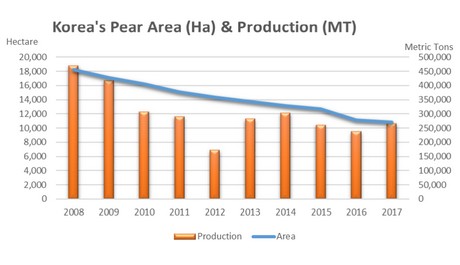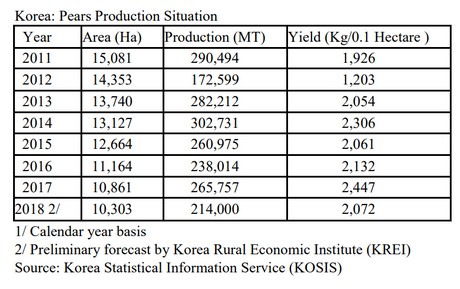In marketing year (MY) 2018/19 (July – June), Korea’s pear planted area is projected to decrease about five percent to 10,303 hectare (ha) from the previous marketing year, continuing a trend that has been ongoing since MY 2000/01. Korea’s pear planted area has decreased about 41 percent (7,416 ha) in the past decade to 10,861 ha in MY 2017/18 from 18,277 ha in MY 2008/09. After peaking at 26,000 hectares in MY 2000/01, Korea’s pear planted area has steadily decreased, due mainly to the following ongoing factors: 1) rapid ageing of the farming population, 2) rapid urbanization of pear farming areas surrounding cities and 3) farmers shifting to more profitable agricultural crops than pears.
Compared with other agricultural crops, pear farming has higher labor costs as it is more labor intensive. Therefore, many older farmers have gradually switched over to more profitable and easier to grow agricultural field crops such as soybeans, sesame seeds, or other fruits including plums, peaches, and kiwi.

As a result of the approximately 41 percent reduction (7,416 ha) of pear planted area over the past decade (MY 2008/09 – 2017/18), Korea’s fresh pear production has also decreased about 44 percent from 470,745 MT to 265,757 MT during the same period. On the other hand, the planted area and the production of other fruits to include tropical and subtropical fruits such as kiwi, mangoes, and passion fruit increased gradually during the same period. For plums, the planted area increased 27 percent to 7,324 ha in 2017 from 5,778 ha in 2008; and the area for mangoes, though still negligible, increased to 32.2 ha from 16.5 ha during the same period.
Production
In MY 2018/19, FAS Seoul projects Korea’s pear production to decrease about 19 percent (52,000 MT) to 214,000 MT from the previous marketing year due to the following reasons: 1) an approximately five percent reduction in planted area, 2) lower yields of approximately 15 percent compared to the previous marketing year caused by lower temperatures in the flowering season in early April and 3) a drought and heat wave during the fruit growing season in August. As a result, the Korean pear industry also forecasts a higher ratio of inferior fruits (including malformed fruits) and a decreased number of large pears per tree this year.

Meanwhile, FAS Seoul has increased Korea’s MY 2017/18 pear production to 265,757 MT, about 12 percent higher than the previous marketing year, due to favorable weather conditions throughout the year. Because of favorable weather, the 2017/18 yield reached a record high level of 2,447 Kilograms per 10 are1 , which was 15 percent higher than the previous year.

As many Korean consumers buy fresh pears for gift-giving and for ancestral food rites during the two Korean holidays (Lunar New Year’s Day and “Chuseok,” the Korean Thanksgiving Day), the demand for the “Singo” pear, a sand pear cultivar that covers about 87% of total pear area, will not be changed in the coming years. The “Singo” pear can be stored longer than other pear cultivars, and there is a strong consumer preference for this cultivar based on its large size.
Consumption
In MY 2018/19, Korea’s fresh pear consumption is projected to decrease significantly to 179,000 MT, a fall of 20 percent from the previous marketing year, mainly due to decreased pear supply that will mean higher prices. Additionally, the increased number of single-member households reduced total pear consumption, since large-sized pears are not a convenient fruit for a single person to consume and store compared to other fruits such as citrus, bananas, and grapes. Moreover, many young Korean consumers think of the pear as a kind of fruit that they enjoy only during the two traditional Korean holidays (Lunar New Year’s Day and the Korean Thanksgiving Day) or fruits for ancestral rites on a special day.
In MY 2017/18, pear consumption reached 223,100 MT, an 11 percent increase from the previous marketing year, due to increased domestic production that resulted in retail prices that were, on average, 5.7 percent lower than the previous marketing year.





